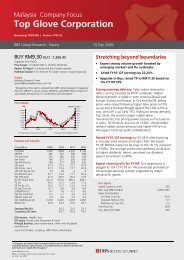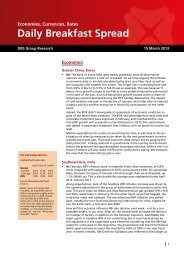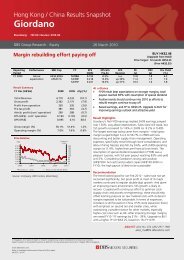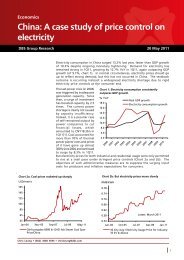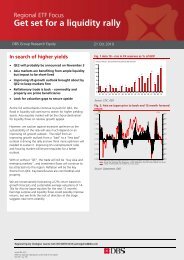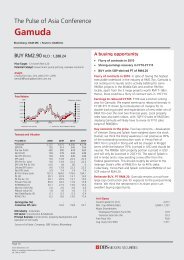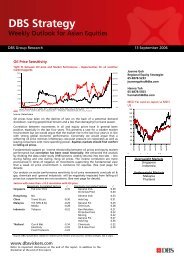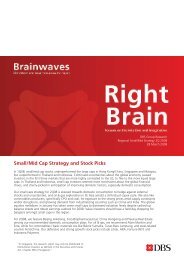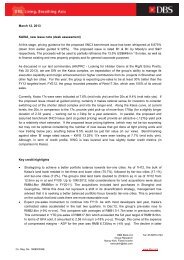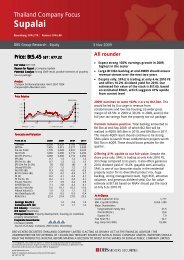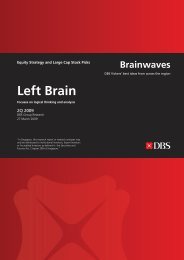Economics Markets Strategy - the DBS Vickers Securities Equities ...
Economics Markets Strategy - the DBS Vickers Securities Equities ...
Economics Markets Strategy - the DBS Vickers Securities Equities ...
Create successful ePaper yourself
Turn your PDF publications into a flip-book with our unique Google optimized e-Paper software.
<strong>Economics</strong> – <strong>Markets</strong> – <strong>Strategy</strong><br />
Asian Equity <strong>Strategy</strong><br />
Fig. 7: Table of policy rate forecasts<br />
current 3Q08 4Q08 1Q09 2Q09<br />
US 2.00 2.00 2.50 3.25 4.00<br />
Japan 0.50 0.50 0.50 0.75 0.75<br />
Eurozone 4.00 4.25 4.25 4.25 4.25<br />
Indonesia 8.50 9.25 9.25 9.25 9.25<br />
Malaysia 3.50 4.00 4.00 4.00 4.00<br />
Philippines 5.25 5.75 6.00 6.00 6.00<br />
Singapore* 1.44 1.31 1.52 1.94 2.31<br />
Thailand 3.25 3.25 3.75 3.75 3.75<br />
China 7.47 7.47 7.74 8.01 8.28<br />
Hong Kong* 2.15 1.95 2.35 3.05 3.70<br />
Taiwan 3.50 3.75 3.88 3.88 3.88<br />
Korea 5.00 5.00 4.75 4.50 4.50<br />
India 8.00 8.25 8.25 8.25 8.25<br />
Source: <strong>DBS</strong>. Up / down arrows denote revisions made<br />
since last quarter. First published for 2Q09 figures. * 3-<br />
month interbank rate used. Current as of June 11.<br />
Fig. 8: Table of exchange rate forecasts<br />
current 3Q08 4Q08 1Q09 2Q09<br />
Japan 107 106 107 108 109<br />
Eurozone 1.55 1.52 1.49 1.46 1.43<br />
Indonesia 9,319 9,500 9,600 9,700 9,800<br />
Malaysia 3.27 3.30 3.35 3.40 3.45<br />
Philippines 44.4 45.0 47.0 45.0 45.0<br />
Singapore 1.37 1.38 1.40 1.42 1.44<br />
Thailand 33.1 33.5 34.0 34.5 34.9<br />
China 6.92 6.80 6.75 6.70 6.65<br />
Hong Kong 7.81 7.81 7.83 7.84 7.85<br />
Taiwan 30.4 30.5 31.0 31.5 32.0<br />
Korea 1,025 1,075 1,100 1,075 1,075<br />
India 43.1 43.0 43.5 42.5 42.5<br />
Source: <strong>DBS</strong>. Up / down arrows denote revisions made<br />
since last quarter. First published for 2Q09 figures.<br />
Current as of June 10.<br />
Grappling with Oil<br />
Having said that, rising inflation particularly from<br />
higher energy prices, will have a varying impact<br />
on <strong>the</strong> economies in Asia. Countries that are still<br />
subsidizing fuel prices including Indonesia, Malaysia<br />
and India have cut subsidies by 28.7%, 40% and<br />
10%, respectively (average, depending on fuel<br />
category). This does not bode well for <strong>the</strong> inflation<br />
trend to soften soon in <strong>the</strong>se countries. Interest<br />
rates are likely to rise, whilst fear of social instability<br />
and <strong>the</strong> potential for fur<strong>the</strong>r subsidy cuts will<br />
dampen sentiment. This comes at a time when<br />
<strong>the</strong> political scenes in <strong>the</strong>se countries are becoming<br />
less stable. Indonesia and India will hold <strong>the</strong>ir<br />
general elections next year, while Malaysia's ruling<br />
party just lost its 2/3 majority win in <strong>the</strong> last elections<br />
and political upheaval is budding.<br />
Most importantly, <strong>the</strong>se three countries run large<br />
budget deficits that if left unchecked coupled with<br />
ballooning subsidies because of higher oil prices,<br />
could lead to rating downgrades.<br />
We now have underweight recommendations for<br />
<strong>the</strong>se three countries.<br />
Dollar rebound<br />
Secondly, with <strong>the</strong> pause in <strong>the</strong> US monetary easing<br />
cycle, <strong>the</strong> USD might not weaken as much as in<br />
<strong>the</strong> first half this year. And some Asian currencies<br />
may find difficulty streng<strong>the</strong>ning. Hence, <strong>the</strong>re are<br />
threats of higher Asian interest rates if currencies<br />
cannot help tame inflation. We have pencilled in<br />
more rate hikes or brought forward <strong>the</strong> rate hikes<br />
for some.<br />
The only country for which we still have a rate cut<br />
forecast is Korea. Our modelling suggests that a<br />
weaker currency and lower interest rates are positive<br />
drivers for Korea's 12-month forward return. Hence,<br />
in line with a positive outlook to <strong>the</strong> growth scenario,<br />
we are raising Korea to Neutral from Underweight.<br />
(See section on Korea)<br />
Rising bond yields<br />
Thirdly, bond yields are expected to rise from here<br />
as <strong>the</strong> bond market starts to price in rate hikes.<br />
We expect <strong>the</strong> US 10-year bond yield to rise to 5%<br />
from 3.8% currently. The implications for equities<br />
are that equities will be deemed expensive in a<br />
rising interest rate environment, but our stress test<br />
suggests that <strong>the</strong> bond / earnings yield relationship<br />
is still within <strong>the</strong> one standard deviation band.<br />
Fig. 9: US / Asia ex-Japan earnings yield ratio - proforma<br />
at US 10-year bond yield = 5%<br />
2.0<br />
1.8<br />
1.6<br />
1.4<br />
1.2<br />
1.0<br />
0.8<br />
0.6<br />
0.4<br />
(x)<br />
93 94 95 96 97 98 99 00 01 02 03 04 05 06 07 08<br />
Source: <strong>DBS</strong>, Datastream, Bloomberg<br />
<strong>Equities</strong><br />
expensive<br />
<strong>Equities</strong><br />
cheap<br />
59



